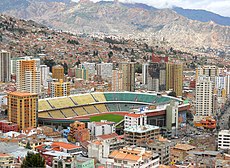Culture of Bolivia
| Part ofa serieson the |
| Culture of Bolivia |
|---|
 |
| History |
| People |

Boliviais a country in South America, bordered byBrazilto the north and east,ParaguayandArgentinato the south,Chileto the west, andPeruto the west.
The cultural development of what is now Bolivia is divided into three distinct periods: pre-Columbian, colonial, and republican. Important archaeological ruins, gold and silver ornaments, stone monuments,ceramics,and weavings remain from several important pre-Columbian cultures. Major ruins includeTiwanaku,Samaipata,InkallaqtaandIskanwaya.The country abounds in other sites that are difficult to reach and hardly explored by archaeologists.
The Spanish brought their own tradition of religious art which, in the hands of local indigenous andmestizobuilders and artisans, developed into a rich and distinctive style of architecture, literature, and sculpture known as "Mestizo Baroque." The colonial period produced not only the paintings of Perez de Holguin, Flores, Bitti, and others, but also the works of skilled but unknownstonecutters,woodcarvers,goldsmiths,andsilversmiths.An important body of native baroque religious music of the colonial period was recovered in recent years and has been performed internationally to wide acclaim since 1994. Bolivian artists of stature in the 20th century include, among others,Guzman de Rojas,Arturo Borda,María Luisa Pacheco,Master William Vega,Alfredo Da Silva,andMarina Núñez del Prado.
Festivals
[edit]Paganrites from thepre-Columbianera are still common during the religious festivals of the Natives. The clothing used during the festivals is reminiscent of the dress of pre-Columbian Indians and 16th centurySpaniards.The at the annualcarnival of Oruroare among the great folkloric events of South America, as are the lesser known indigenousAnata Andinaand the "carnival" at Tarabuco (Pujllay), or theTinku- fertility rites held at Macha every 3 May. They also celebrate Dia de los Muertos.
Dances
[edit]
Many dances and songs contain elements from both the native and European cultures.Caporalesseems to be the most popular Bolivian dance of present times – in a few decades it has developed into an enormously popular dance, not only in the Highlands where it originated, but also in the Lowlands and in Bolivian communities outside the country. In the Highlands, other traditional and still very popular dances are:
- Awki awki
- Cambitas
- Ch'utas
- Diablada
- Kullawada
- Llamerada
- Morenada
- Pukllay
- Afro-BolivianSaya
- Siklla(Wayra, Doctorcitos)
- Suri Sikuri
- Tango
- Tinku
- Tobas
- Waka Waka
In the Lowlands, there are:
- Macheteros
- Taquirari
- Chovena
Clothing
[edit]
Clothing of Andean people of indigenous descent includes thepollera(pleated-skirt), the 19th century Europeanbowler hat,and a silky shawl known as amanta.[1]The pollera was originally a simple Spanish dress that colonial authorities forced the indigenous populations to wear. The pollera is a symbol of pride for theindigenous people,who live in La Paz, and for people in rural areas.
The inhabitants of Santa Cruz de la Sierra, from babies to seniors, wear the same kind of clothes that are typical in western countries, like jeans, shorts (which are the most common because of the heat), t-shirts, dresses, etc.
Sports
[edit]Association footballis the most popular sport in Bolivia. The governing body of football in Bolivia is theFederación Boliviana de Fútbol(FBF), which controls the national teams. The FBF organises themen's,women's,andfutsalnational teams.
TheBolivia national football teamis currently ranked 75th in the world, with their bestFIFA rankingbeing 18th in the world. The national team has competed at theFIFA World Cupthree times, theCopa América23 times, and theConfederations Cuponce.
La Paz has the highest tournament-class golf course in the world.
Bolivia's national basketball teamfinished 8th at the2016 South American Basketball Championship.There, Bolivia beatEcuador75-74 for its first victory ever at the event.Bolivia's women's national basketball teamwon the silver medal at the 1978South American Basketball Championship for Women.
Stadiums in Bolivia
[edit]
For football stadiums in Bolivia, seeList of football stadiums in Bolivia.Indoor stadiums in Bolivia can be found in the table below.
| Rank | Venue | Date built | Capacity | City | Image |
|---|---|---|---|---|---|
| 1 | Polideportivo Evo Morales | 2015 | 12,000 | Quillacollo | |
| 2 | Coliseo Julio Borelli Viterito | 1977 | 10,000 | La Paz | |
| 3 | Polideportivo Garcilazo | 2009 | 10,000 | Sucre | |
| 4 | Polideportivo Héroes de Octubre | 2013 | 10,000 | El Alto | |
| 5 | Coliseo Eduardo Leclere Polo | 2000 | 10,000 | Oruro |
Cuisine
[edit]Bolivian cuisinestems mainly from the combination ofSpanish cuisinewith traditional native Bolivian ingredients, with later influences fromGermans,Italians,Basques,Croats,Russians,andPoles,due to the arrival of immigrants from those countries. The three traditional staples of Bolivian cuisine aremaize,potatoes,andbeans.These ingredients have been combined with a number of staples brought by the Europeans, such asrice,wheat,and meat, such asbeef,pork,andchicken.
Music
[edit]
Bolivia's regionalfolk musicis distinctive and varied. In the Andean regions, music is played during the festivals and dances. Some tunes contain strong Spanish influences.
The most common musical instruments are:
- Sicu(alsosicus)
- Tarkaortharqa
- Pinkillo
- Skin drums
- Copper bells
- Wood
- Guitar
- Flute
- Zampoña
- Matraca
- Mandolina
- Charango
- Quena
See also
[edit]- Architecture of Bolivia
- Andean culture
- Hispanic culture
- Latin American culture
- Performing Life, Inc,NGO
- Lists of stadiums
References
[edit]This articleneeds additional citations forverification.(September 2014) |
- ^Forero, Juan."Women leave traditional Bolivian dress in closet".The New York Times.RetrievedApril 5,2013.


